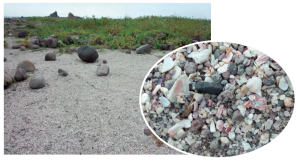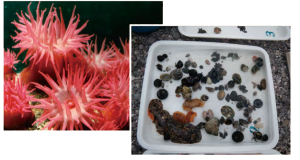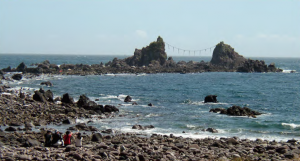Mitsuishi coast
Along one stretch of the Mitsuishi coast, you can see lava that spewed from the Earth approximately 150,000 years ago. The three giant rocks at the end of the cape are called “Mitsuishi,” meaning “three rocks.” It is thought that oceanwaves eroded the solidified lava into its current shape. The nearby rocky beach is home to diverse wildlife thanks to the coastal forest that has been maintained by the local people for more than three centuries. The seashore here is home to shellfish, shrimp, crab, finfish and other species.
*Please do not remove plants or animals from their natural habitat.
The sands in Mitsuishi Coast
There is no river flowing in Mitsuishi Coast. Therefore the sands in Mitsuishi Coast are made from lava and crushed seashells. These sands are called as “shell sands”. At the coast of shell sands, a lot of unique plants which are not living at the other sand coast can be seen.
Creature of the abundant sea
Among the area facing Sagami Bay, the coast this area is one of the treasure-trove of sea creatures. More than 100 kind of rocky shore creature can be found, when the sea is good condition, such as actiniidae, national monument of Kanagawa prefecture.
Difference of the high and low tide
At the spring tide from spring to summer, low tide comes daytime. Usually Mitsuishi is located at offshore, but during spring tide period, Misuishi is connected to sea coast. Therefore, Mitsuishi Coast is an ideal place to observe difference of the high and low tide.
Scenic spot Mitsuishi
Mitsuishi is famous as the place to see the first sunrise of the new year, and a lot of people visit here on the January 1 morning. The distant scenic view is also beautiful. The sunrise can be enjoyed throughout the year not only January 1.
*Photo: From Banbaura Coast



